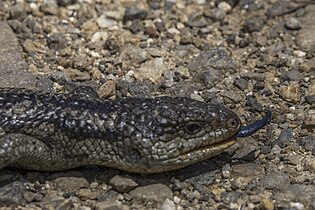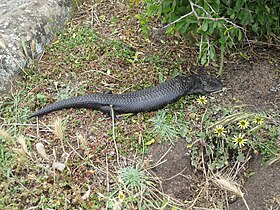Blotched blue-tongued lizard
| Blotched blue-tongued lizard | |
|---|---|

| |
| Ben Lomond National Park, Tasmania, Australia | |
| Scientific classification | |
| Domain: | Eukaryota |
| Kingdom: | Animalia |
| Phylum: | Chordata |
| Class: | Reptilia |
| Order: | Squamata |
| Family: | Scincidae |
| Genus: | Tiliqua |
| Species: | T. nigrolutea |
| Binomial name | |
| Tiliqua nigrolutea | |
The blotched blue-tongued lizard (Tiliqua nigrolutea), also known as the southern blue-tongued lizard or blotched blue-tongued skink is a blue-tongued skink endemic to south-eastern Australia.
Description
This species is a relatively large member of the skink family (Scincidae) with a robust body and relatively short limbs. Colouration and pattern varies geographically, with two distinct forms recognised by some herpetologists, i.e lowlands and highlands. The lowlands form tends to be shades of grey or brown with paler silvery to tan coloured blotches along the back, that are contrasted by surrounding darker areas. The highlands form is typically darker (often jet black) that provides a strong contrast to much paler cream or more brightly coloured pink, salmon or orange coloured blotches.
They have a fleshy blue tongue that is used to taste the air and scare off potential predators. They tend to rely on camouflage and bluff as their primary means of defence; however, if cornered or molested, they can put on an impressive and effective defensive display. If further molested, it will bite as a last resort and although the bite can be painful due to its powerful jaws, the teeth are blunt and generally do not break the skin. This species is harmless, as are all skinks and inoffensive by nature. They are sometimes kept as pets, as they adapt well to captivity, eating a wide range of readily available foods.
The lizard is about 14 to 20 inches (35 to 50 cm) long, and is found in wet and dry sclerophyll forests, montane woodlands and coastal heathlands. It is an omnivore with a diet consisting of a variety of insects, snails, carrion, wildflowers, native fruits and other vegetation like select leaves, and occasionally small vertebrates like mice or other young rodents if given the chance. The tail can be dropped (autotomy) when grasped by a predator (like most skinks), but this large skink is much less likely to do so than most other members of the skink family.
Distribution and habitat
The species occurs in Victoria, Tasmania, South Australia, New South Wales, and the Australian Capital Territory.[1] The lowlands form is found in Tasmania and lower altitudes of Victoria right down to the coast. The highlands form is restricted to higher altitudes in NSW and the high country of Victoria. The blotched blue-tongued lizard usually emerges from brumation in early spring, which is the mating season. These large skinks are viviparous (give birth to live young), with the highland/alpine form giving birth to relatively larger and fewer young (about five) compared to the lowland form (about 11). The young are usually born in autumn, after a relatively long gestation period.[2] They are also relatively long-lived (reliably reported up to 30 years in captivity) compared to many of the smaller skink species. They have adapted well to some rural and urban areas, where they can be found living on farms and in gardens where they are an asset, as they eat pests such as snails, slugs, and occasionally rodents.
The blotched blue-tongued lizard is among the animals identified from the Pleistocene fossil sites of the Naracoorte Caves National Park.
Gallery
- Showing blue tongue, Ben Lomond, Tasmania
- Head of blotched blue-tongued lizard
- Gravid female
References
- ^ a b Gillespie, G.; Hutchinson, M.; Melville, J.; Michael, D.; Clemann, N.; Chapple, D.G.; Robertson, P. (2018). "Tiliqua nigrolutea". IUCN Red List of Threatened Species. 2018: e.T109481446A109481473. doi:10.2305/IUCN.UK.2018-1.RLTS.T109481446A109481473.en. Retrieved 19 November 2021.
- ^ Edwards A, and Jones S.M. (2004). Parturition in the Blotched Blue-tongued Lizard, Tiliqua nigrolutea, in captivity. Herpetofauna. 34 113-118.
- Cogger H, (2000) Reptiles & Amphibians of Australia
Further reading
- Edwards A. and Jones S.M. (2003). Mating behaviour in the blotched blue-tongued lizard, Tiliqua nigrolutea, in captivity. Herpetofauna 33 60-64.
- Edwards A., Jones S.M. and Davies N.W. (2003). Sex and season influence gonadal steroid biosynthetic pathways, end-product production and steroid conjugation in blotched blue-tongued lizards (Tiliqua nigrolutea). Gen. Comp. Endocrinol. 134 131-138.
- Edwards A., Jones S.M., and Wapstra, E. (2002). Multiennial reproduction in females of a viviparous skink, Tiliqua nigrolutea. Herpetologica 58 407-414.
- Gartrell B.D., Girling, J.E., Edwards A., and Jones S.M. (2002). Comparison of noninvasive methods for the evaluation of female reproductive condition in a large viviparous lizard, Tiliqua nigrolutea. Zoo Biol. 21 253-268.





